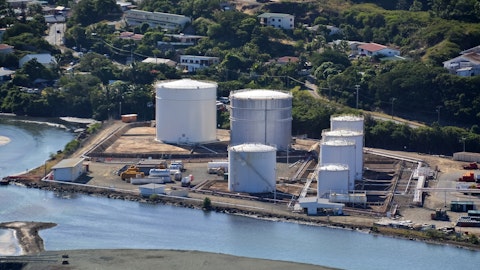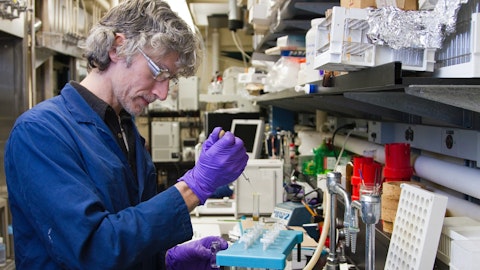Applied Materials, Inc. (NASDAQ:AMAT) Q4 2022 Earnings Call Transcript November 17, 2022
Applied Materials, Inc. beats earnings expectations. Reported EPS is $2.03, expectations were $1.73.
Operator: Welcome to the Applied Materials Earnings Conference Call. During the presentation, all participants will be in a listen-only mode. Afterwards, you will be invited to participate in a question-and-answer session. I’d now turn the conference over to Michael Sullivan, Corporate Vice President. Please go ahead, sir.
Michael Sullivan: Good afternoon, everyone, and thank you for joining Applied’s Fourth Quarter of Fiscal 2022 Earnings Call. Joining me are Gary Dickerson, our President and CEO; and Brice Hill, our Chief Financial Officer. Before we begin, I’d like to remind you that today’s call contains forward-looking statements, which are subject to risks and uncertainties that could cause our actual results to differ. Information concerning the risks and uncertainties is contained in Applied’s most recent Form 10-Q and 8-K filings with the SEC. Today’s call also includes non-GAAP financial measures. Reconciliations to GAAP measures are found in today’s earnings press release and in our quarterly earnings materials, which are available on the IR page of our website at appliedmaterials.com.

Photo by Misael Moreno on Unsplash
Before we begin, I have a calendar announcement. Applied plans to hold an eBeam technology and new product webcast on Wednesday, December 14 at 9:00 a.m. Pacific Time. Please stay tuned for an invitation to join our presenter, Keith Wells, who is Group Vice President and General Manager of our Imaging and Process Control Group. And with that introduction, I’d like to turn the call over to Gary Dickerson.
Gary Dickerson : Thank you, Mike. Applied Materials delivered a strong finish to our fiscal year with record quarterly performance. Throughout 2022, the company has demonstrated solid execution while navigating COVID-related restrictions, supply chain shortages, and a challenging geopolitical and macroeconomic environment. I would like to recognize the hard work and commitment of our global team and our suppliers who are doing everything possible to meet our customers’ needs. As this is our year-end call, I’ll begin my prepared remarks with a quick review of our performance and progress over the past 12 months. I’ll then give our latest outlook for 2023 before describing our longer-term growth thesis for the industry and Applied.
After that, Brice will provide more color on our financial performance and key areas of operational focus. Like many others in the technology sector, our performance and priorities in 2022 have been shaped by an unprecedented set of challenges. Our top priority has been mitigating supply chain constraints that prevented us from fully meeting customer demand. In Q4, we made incremental progress, and we expect to continue closing supply gaps over the next few quarters. As well as finding creative short-term solutions, our team has been addressing root causes and building a more resilient, scalable supply chain and stronger strategic relationships with our suppliers. In addition, we are strengthening our own manufacturing, logistics and supply chain management.
While I’m pleased with the recent improvements in supply chain performance, we are still supply chain limited across a number of key product lines and our backlog grew in Q4. The biggest supply constraints are in our metal deposition business, where customer demand is very strong. This is our largest business unit and where we have highly differentiated solutions for advanced foundry/logic and DRAM. The market for these products, which enable next-generation wiring, is expanding considerably. In addition to supply shortages, we’re also navigating a difficult geopolitical environment as reflected in the new export control regulations enacted by the U.S. government on October 7. These new rules are complex and cover a broad range of semiconductor technology that includes wafer fabrication equipment and related parts and services.
We have taken all the necessary actions to comply with these new rules, including suspending shipments and support where required. We estimate that the unmitigated impact to our fiscal 2023 revenues could be up to $2.5 billion. We believe the actual impact can be reduced to $1.5 billion to $2 billion. This will depend in part on how quickly the government provides licenses and approvals as well as how impacted companies refocus their investments. We are also mindful of the macroeconomic headwinds, including inflation and softening consumer demand. To offset the inflationary cost increases we are facing, we are driving multiple initiatives that include reengineering our products and implementing price adjustments. While it’s too early to forecast 2023 with any precision, I can describe what we’re currently seeing in the market and hearing from our customers.
Starting with memory, spending is expected to be down year-on-year as weakness in consumer electronics and PCs prompts some customers to defer capacity additions. In leading-edge foundry/logic, demand looks strong, with customers racing for leadership and driving major technology inflections that determine their relative competitive positions. In ICAPS, chips for the IoT, communications, auto, power and sensor markets, demand is mixed. Consumer-driven markets are clearly softer, while the automotive, industrial and power markets remain robust. Those investments are underpinned by large inflections, including the transition to electric vehicles, accelerated adoption of industrial automation and growing demand for renewable energy solutions, especially in Europe.
While all of this adds up to an expected pullback in overall wafer fab equipment spending next year, we believe that Applied’s business will be more resilient than the underlying market for three key reasons. First, we have a significant backlog, the highest in our history, measured on both an absolute and percentage of revenue basis; second, demand for some of our most differentiated product lines where we have uniquely enabling technology remains much higher than our capacity to fulfill that demand; and third, our service business is positioned for steady growth with an increasingly large portion of this business being converted to subscriptions. Over the past 12 months, our installed base of systems grew 8% and the number of tools under comprehensive long-term service contracts grew 16%.
The renewal rate for these agreements is well over 90%, which demonstrates the value customers see in our subscription services. Looking further ahead, our long-term growth thesis for the industry and Applied Materials has not changed. Semiconductors are the foundation of digital transformation that will touch almost every sector of the economy over the coming years. This puts the semiconductor industry on a path to a $1 trillion market by the end of the decade. And while every year will not be an up year, the overall trajectory is clear. We also like where Applied Materials plays within the ecosystem. As technology complexity is increasing, we expect equipment intensity to remain at today’s levels or rise further. This means wafer fab equipment is likely to grow faster than the overall semiconductor market.
Within equipment spending, major technology inflections are enabled by materials engineering, shifting more dollars to Applied’s available markets over time. We think about the industry’s future road map in terms of power, performance, area cost and time to market. The PPACt playbook has five pillars: new architectures, new 3D structures, new materials, new ways to shrink and advanced packaging, with each pillar made up of multiple technology inflections. For example, new 3D structures like gate-all-around transistors and backside power distribution networks are materials engineering enabled inflections that grow Applied’s total available market. As I referenced earlier, wiring is a key bottleneck for chip performance and power at advanced nodes.
And this is driving significant innovation in new materials. Between the 7- and 3-nanometer node, contact metallization steps are growing more than 50% and our total available market is expanding almost 80%. For interconnect layers, process steps are being added even faster, and we expect our revenue opportunity to approximately triple through these node transitions. Advanced packaging represents a new era for integrated circuit design that opens major new vectors of innovation for chip designers. Advanced packaging is also enabled by new materials engineering solutions. Although the industry is still in the early stages of adoption, we have already grown our packaging equipment business to nearly $1 billion. Our process diagnostics and controls business also has broad exposure to these inflections and delivered significant growth in 2022.
Our progress and opportunities in e-beam will be the focus of our December technology briefing. Given our positive long-term view of the semiconductor market, the outsized opportunities for Applied Materials within the market and favorable global government incentives, we are making investments in R&D and infrastructure to support industry growth and position the company for future success. We will provide more details about our specific plans in the coming months. At the same time, with the current macroeconomic conditions, we are carefully managing discretionary spending and limiting hiring to only strategic positions. Before I hand the call over to Brice, I’ll quickly summarize. Applied Materials ended the year strong with record performance.
In the past quarter, we made incremental progress overcoming the supply challenges that have constrained our performance in fiscal 2022. However, there is still work to do and our backlog continues to grow. We expect 2023 to be a down-year for wafer fab equipment spending, but we believe that Applied’s business will be more resilient thanks to our large backlog, growing service business and strong customer demand for our leadership products that enable key technology inflections. Longer-term, secular trends create opportunities for Applied to outgrow the semiconductor market by enabling the PPACt roadmap with our differentiated portfolio of materials engineering solutions. We are making strategic investments for the future, while slowing spending growth in the near-term.
Now, I’ll hand over to Brice.
See also 15 Most Hated Companies in the US and 30 Wealthiest Families in the World.
Brice Hill : Thank you, Gary. I’d like to start by thanking our team and our supply chain partners for helping to further increase our output for our customers. On today’s call, I’ll summarize our results for the fiscal year and Q4 as well as provide our guidance for Q1. I’ll also discuss the impact of recent U.S. export regulations on our revenue and gross margin. Before going into the results, I’d like to make three points. First, despite a weaker customer demand outlook, we generated strong orders in Q4 and ended the year with record backlog, particularly in some of our leadership product areas. Combined with the resiliency of our AGS business, the strong backlog puts us in a good position to offset some of the market weakness expected next year.
Second, we have not changed our view of a $1 trillion semiconductor market by 2030 and with a high single-digit CAGR for semiconductors and similar or faster growth for equipment due to added process complexity. We grew our headcount in R&D spending significantly in 2022 to develop new leadership products and further expand our broad portfolio. While we are slowing our spending growth in the current environment, we remain committed to research and development, enabling critical inflections that support our customers’ roadmaps. And third, we returned nearly $7 billion to shareholders this past year, including buybacks equivalent to 6% of shares outstanding at the beginning of the period. With record demand and financial results in 2022, a strong growth opportunity through 2030 and our broad and unique portfolio of systems and services, we’re confident in our financial position and our future.
Next, I’ll summarize our fiscal year results. Although supply chain constraints impacted our output all year, we delivered record annual revenue and EPS. On a year-over-year basis, revenue increased nearly 12% to $25.8 billion. Non-GAAP gross margin decreased by around 90 basis points to 46.6%. Non-GAAP operating profit grew by over 7% to $7.86 billion. Non-GAAP operating margin decreased by 120 basis points to 30.5%. And non-GAAP EPS increased nearly 13% to $7.70. We generated about $5.4 billion in operating cash flow this past year and over $4.6 billion in free cash flow. We returned 151% of free cash flow to shareholders, including $873 million in dividends and $6.1 billion in share repurchases. Our cash returns for the past three years were equivalent to over 100% of free cash flow.
In the year, demand for our products and services was very strong with record annual bookings in semi systems and AGS. On a year-over-year basis, our total ending backlog increased 62% to $19 billion. Our semi systems backlog increased 90% to nearly $12.7 billion. We expect to reduce our semi systems backlog as supply chain performance improves. Our AGS backlog increased 30% to over $5.6 billion. The strong AGS backlog reflects a large increase in long-term service agreements, which gives us confidence in the continued growth of this business. Moving to our Q4 results. We delivered record quarterly net sales of nearly $6.75 billion and record non-GAAP EPS of $2.03. Non-GAAP gross margin declined 20 basis points sequentially to 46%. And non-GAAP OpEx grew 3.5% sequentially to nearly $1.1 billion, with most of the increase in R&D.
Turning to the segments. Semi Systems revenue grew more than 6% sequentially to $5.04 billion. Segment non-GAAP operating margin increased 80 basis points sequentially to 36.9%. AGS revenue was flat quarter-over-quarter at $1.42 billion. Segment non-GAAP operating margin declined to 28.3%. AGS key performance indicators continue to be positive with strong year-over-year growth in installed base systems, service intensity and subscription agreements. As a result, AGS continues to grow faster than the pace needed to achieve our long-term revenue targets. Moving on to Display. Revenue declined as expected to $251 million. Segment non-GAAP operating margin also declined to 13.5%. Turning to our cash flows. We generated $857 million in operating cash flow during the quarter, which was 13% of revenue.
We returned over $1.72 billion to shareholders, including $223 million in dividends and $1.5 billion in buybacks. We repurchased 17 million shares at an average price of $88.05. Next, I’ll discuss the impact of the new U.S. export regulations to Applied Materials. We currently expect that the unmitigated revenue impact of the new rules could be up to $2.5 billion in fiscal 2023. We continue to work through the regulatory requirements, including seeking licenses and approvals where appropriate. We hope to reduce the revenue impact by between $500 million and $1 billion to a net impact of $1.5 billion to $2 billion. We also expect the rules to reduce our non-GAAP gross margin by up to 1 percentage point. While this creates a headwind to meeting our gross margin targets for 2024, we remain committed to our goals and believe we can even exceed them over time.
In Q4, the new rules reduced our Semi Systems and AGS revenue by approximately $280 million, which was in the range of our expectation on October 12. Inventory charges in Q4 were lower than our preliminary assessment. In Q1, we expect the new rules to reduce Semi Systems and AGS revenue by approximately $490 million combined and reduce our gross margin by around 1 percentage point, both on an unmitigated basis. Now I’ll share our guidance for Q1. We expect revenue to be $6.7 billion, plus or minus $400 million, and we expect non-GAAP EPS of $1.93, plus or minus $0.18. Within this outlook, we expect Semi Systems revenue to be about $5.15 billion, which is up nearly 13% year-over-year. We expect AGS revenue to be about $1.33 billion, which is slightly up year-over-year.
Display revenue should be around $170 million. We expect non-GAAP gross margin to be approximately 46.1% and we expect non-GAAP operating expenses to be $1.16 billion. We are modeling a tax rate of 13%, which is up from 11.8% last year, primarily due to mandatory capitalization of R&D expenses effective in our new fiscal year. Before we begin the Q&A, I’d like to summarize our company’s position in the current environment. We have record backlog, notably in the highly enabling technologies for next-generation nodes. Our supply chain and manufacturing output are incrementally improving. We expect our services business will continue to grow and generate strong recurring revenue and free cash flow. And the longer-term growth outlook for the semiconductor industry remains strong.
Applied is in a great position to invest in future growth and deliver strong profitability, free cash flow and shareholder returns. Now Mike, please begin the Q&A.
Michael Sullivan: Thanks, Brice. To help us reach as many people as we can, please ask just 1 question on today’s call. If you have another question, please requeue and we’ll do our best to come back to you later in the session. Operator, let’s please begin.
Q&A Session
Follow Applied Materials Inc (NASDAQ:AMAT)
Follow Applied Materials Inc (NASDAQ:AMAT)
Operator: And our first question comes from the line of C.J. Muse with Evercore ISI.
C.J. Muse: Yes. I was hoping to clarify one thing first on China. And really, the question is, what changed between October 12 with your press release and then October 30, where it looks like there really wasn’t much of an impact at all? And then my — I guess, real question is, as you think about calendar ’23 WFE, it sounds like companies are providing kind of a top-down view that things for WFE are — look weak and declining. However, every company bottoms up based on deferred revenues and backlogs are much more optimistic on the outlook. So can you kind of talk through the moving parts there? And what kind of range or outcome you see today for year-over-year silicon declines in calendar ’23?
Brice Hill: Sure. Hi, C.J., it’s Brice. I’ll start on this one. So relative to the preannouncement that we did, we talked about a $400 million impact, plus or minus $150 million for the China trade change. And then as we work through it, that impact ended up being less around $280 million. And it’s just estimating the transactional elements at the end of the quarter. It was an initial element estimate, so we did a little bit better from that perspective. The other thing that really happened was execution in the end of the quarter was almost flawless from a logistics perspective. We got more supply chain parts in at the end of the quarter. And so, over $200 million of good news from an execution and delivery perspective, finishing product and completions in the field.
So it was really those two things. It was little bit better than our initial estimate and execution was excellent in the last couple of weeks of the quarter. And then on ’23 — the WFE question for ’23, we think that it’s preliminary. It’s too early to give an estimate of ’23. So what we’re trying to share is what we’re seeing in our order patterns and in our business for Q1 and Q2. We talked about in the script, how in Q1 — or in our bookings for Q4, they were really solid. We did see pushouts. We did see weakness in the memory business, but our backlog has grown to a record level of backlog. So when we think about our Q1 and Q2, we’re still supply constrained. We still have a number of different equipment lines that we have significant backlog.
We’re trying to catch up to customer orders. And so the signals to us really are that we have to work on supply chain, work on improving our output and work on catching up with our customers. So beyond that, we’re just not able to make a call yet on WFE for ’23.
Gary Dickerson: Yes. C.J., this is Gary. As Brice said, the — we can certainly give a perspective on our business. We’re not going to guide on overall WFE for ’23. But we’re in a very strong position. If you look at the kind of profile of the business, it’s more weighted towards foundry/logic versus memory. And we have some very strong products where we have significant backlog, and we’re still working to close the supply-demand gaps in those areas. So from Applied’s standpoint, as you know, it’s all about the race for power and performance for all of our customers, and we’re really well positioned with leading products and those big inflections. And again, our #1 focus is on closing the supply chain gaps.
Operator: Thank you. Our next question comes from the line of Stacy Rasgon with Bernstein.





